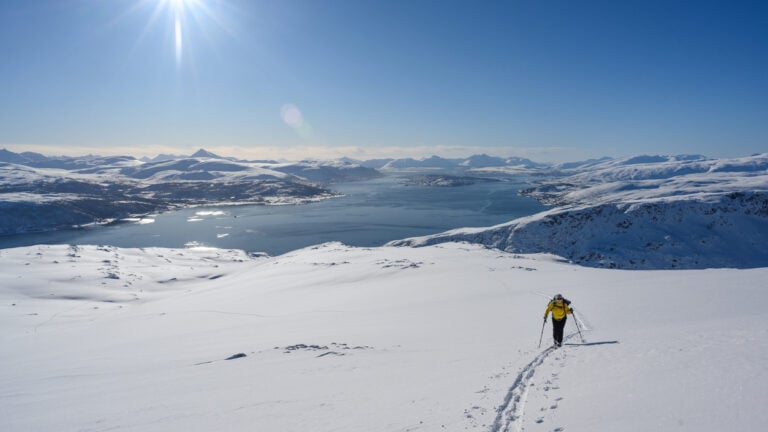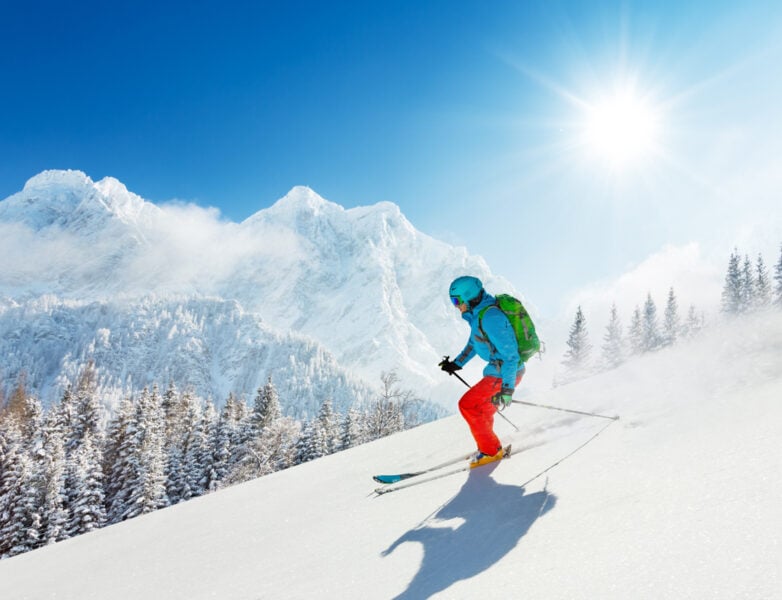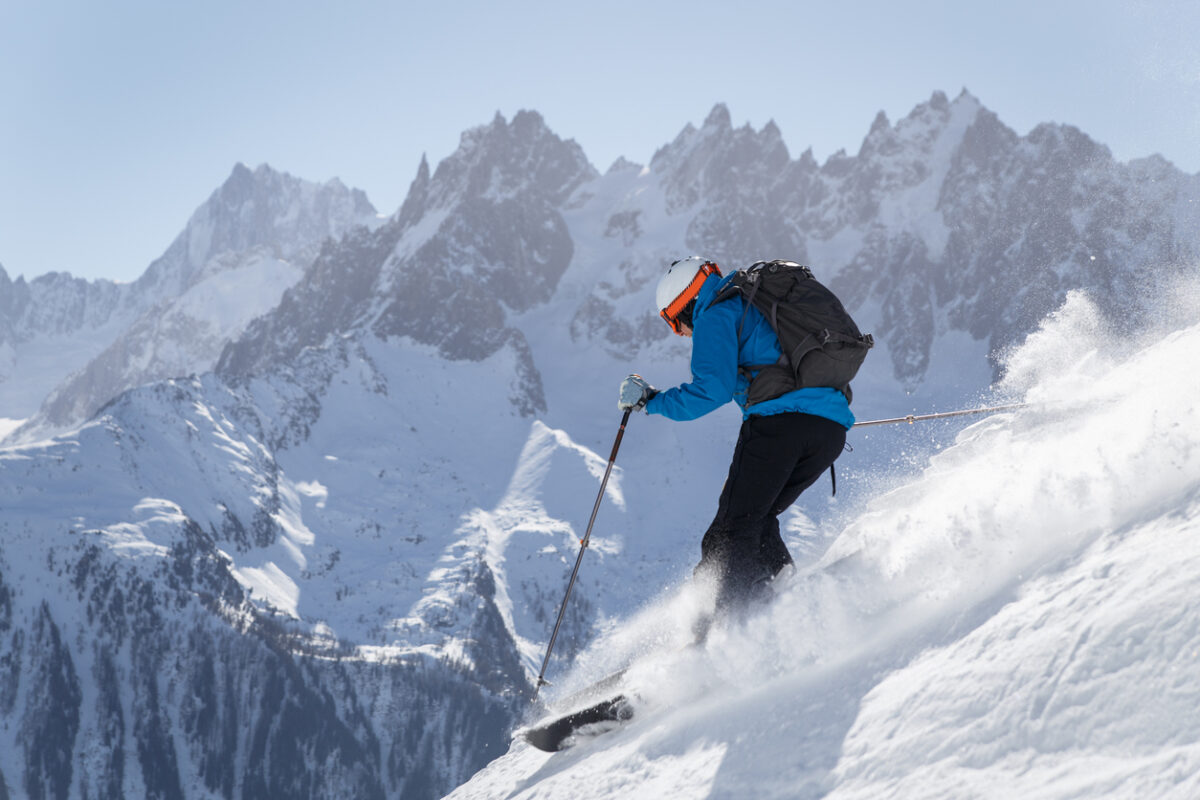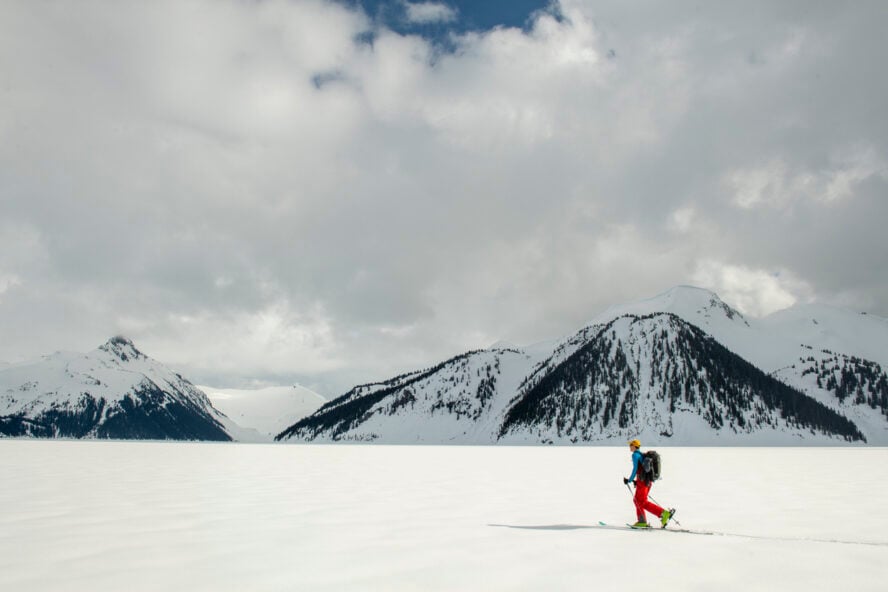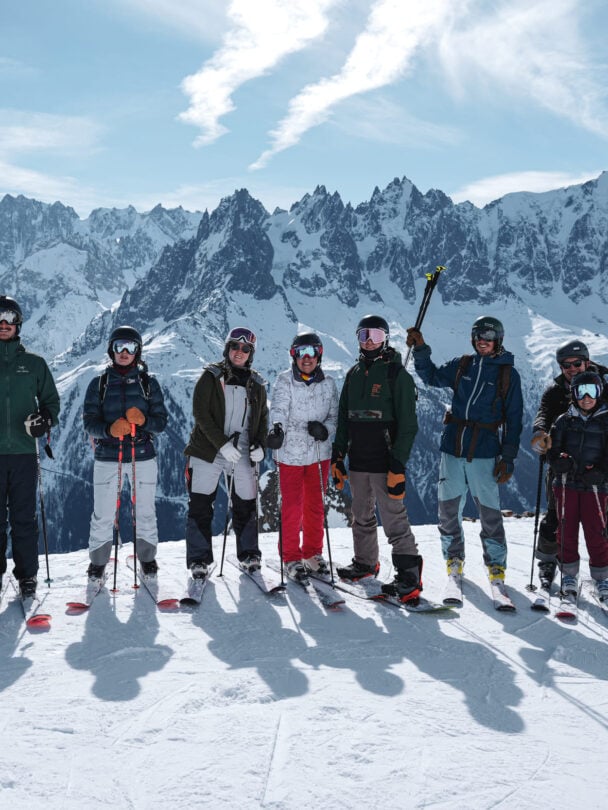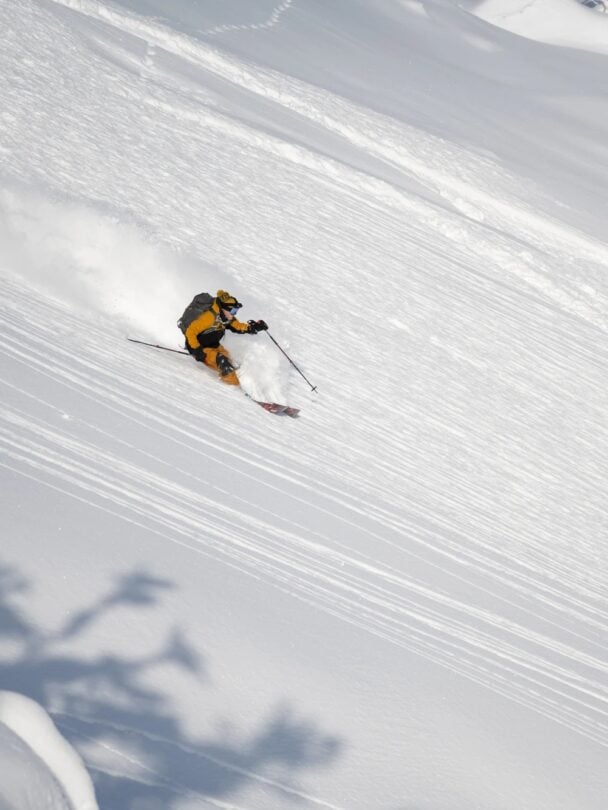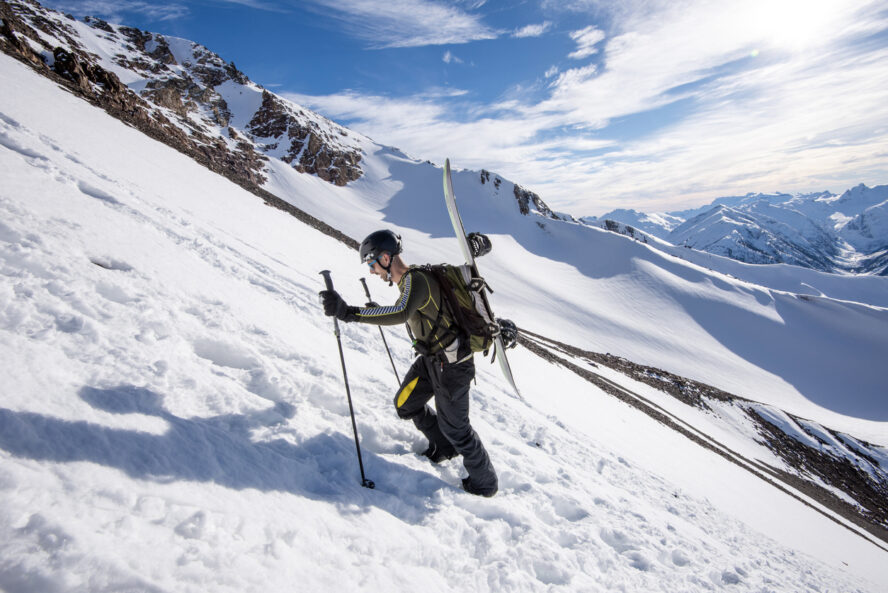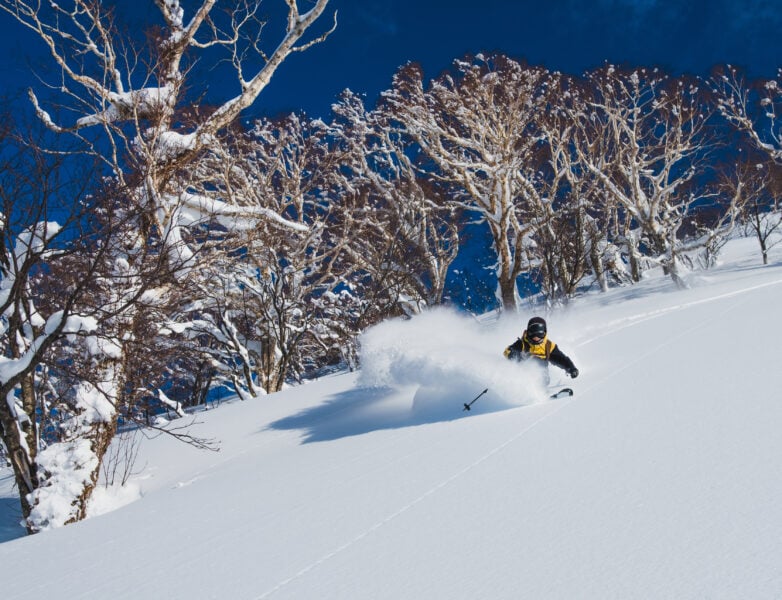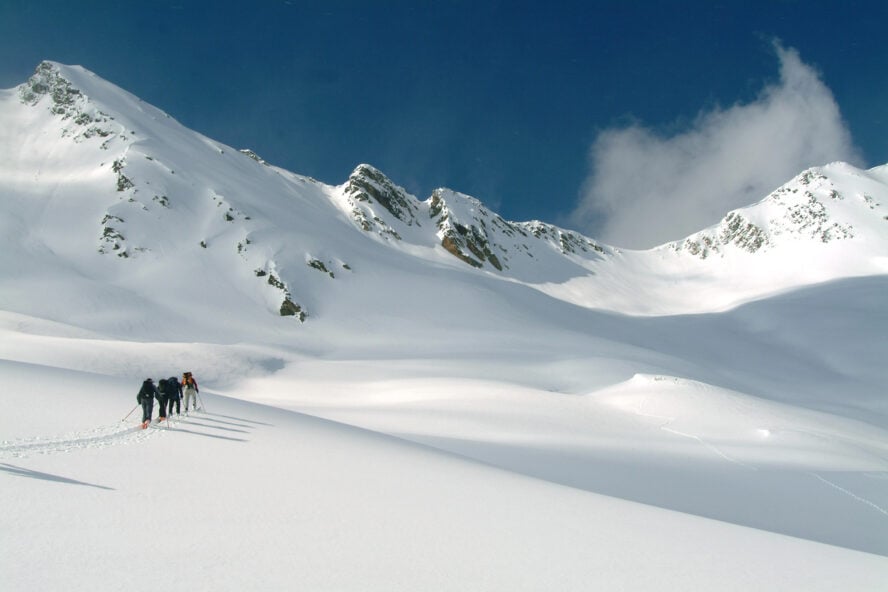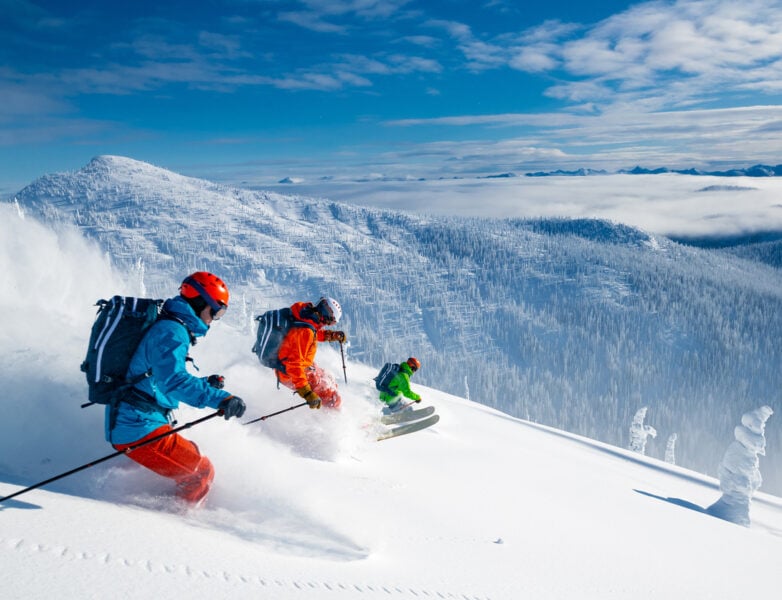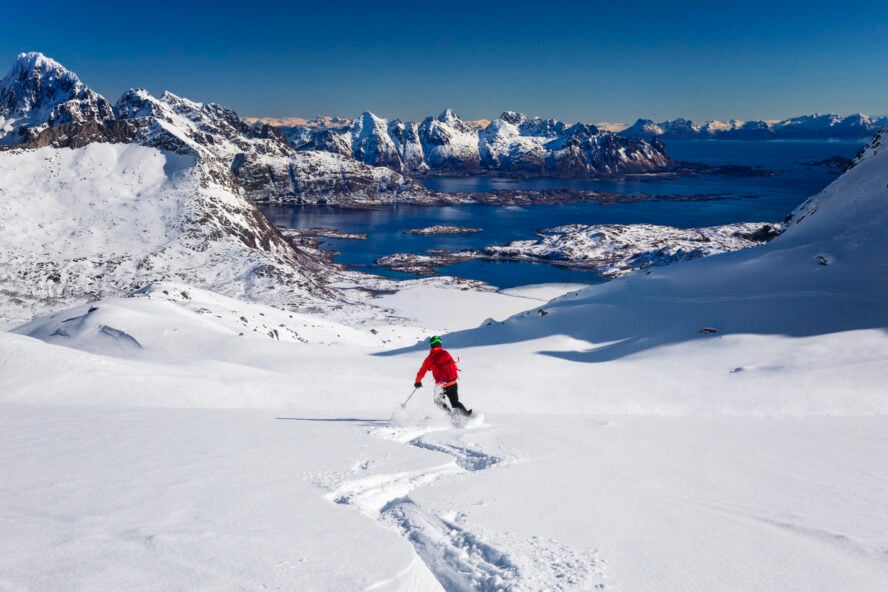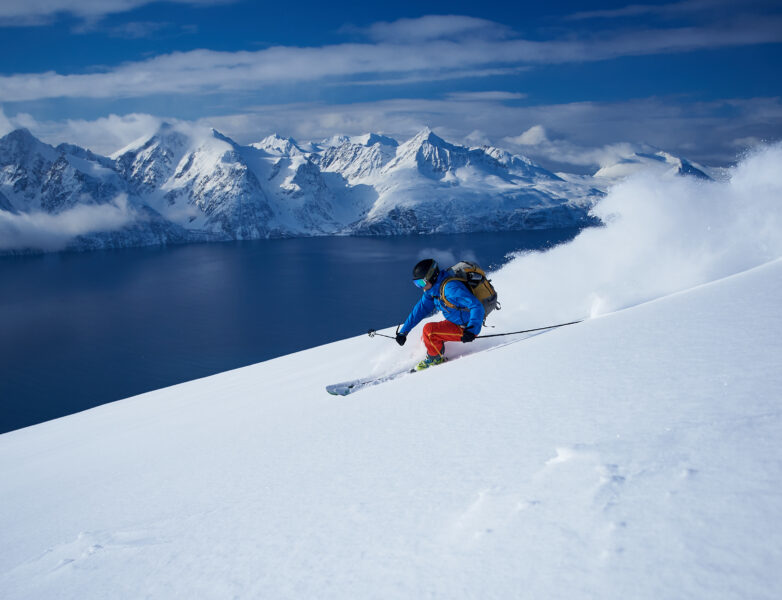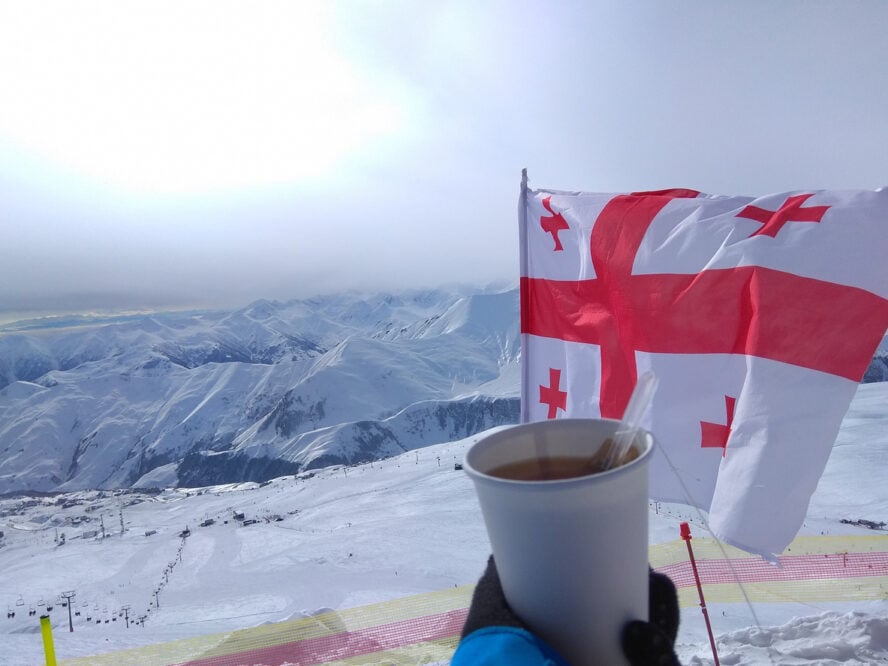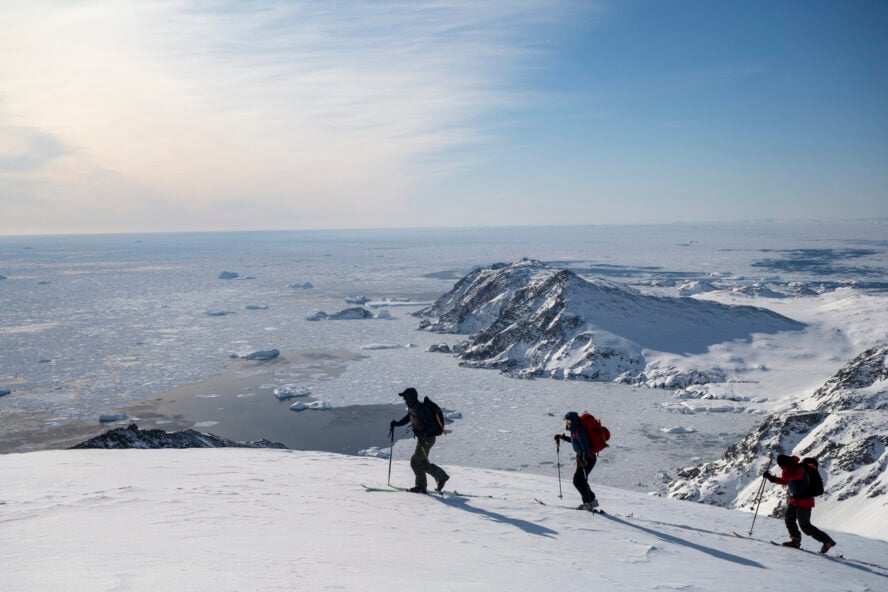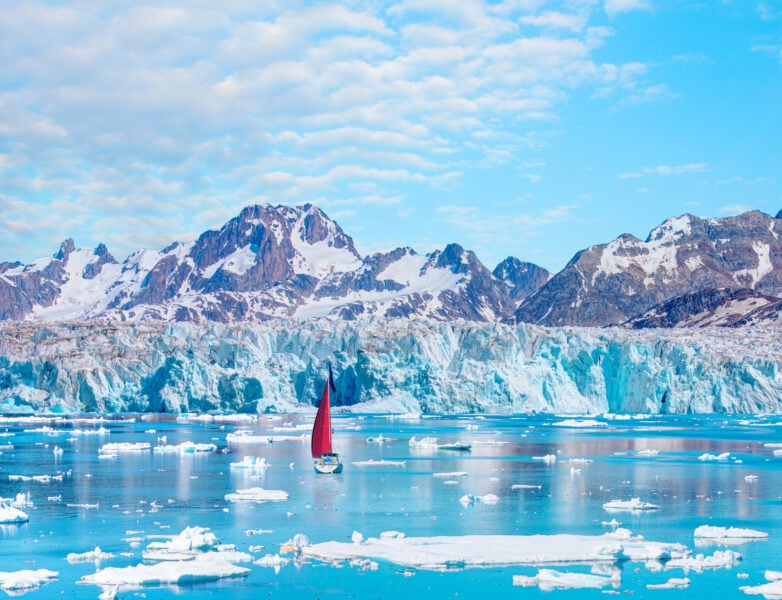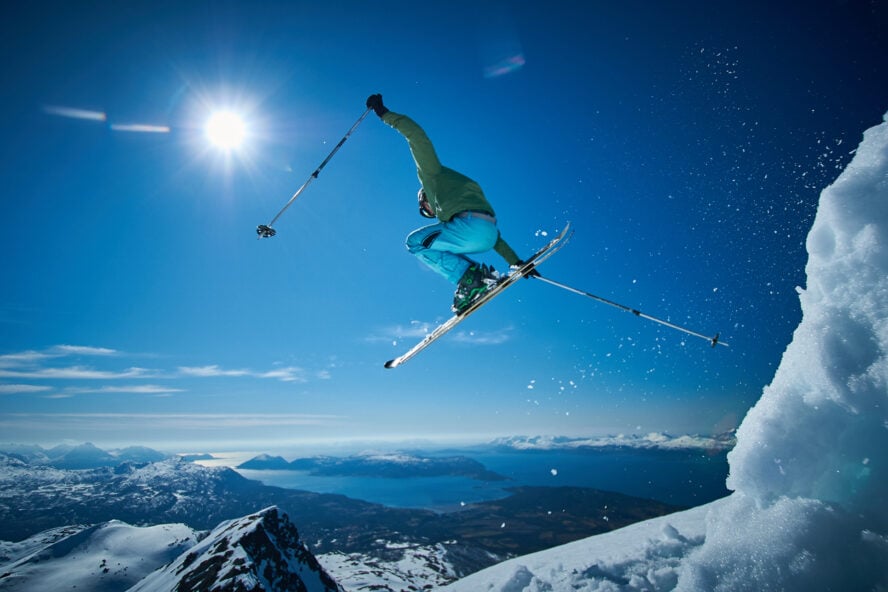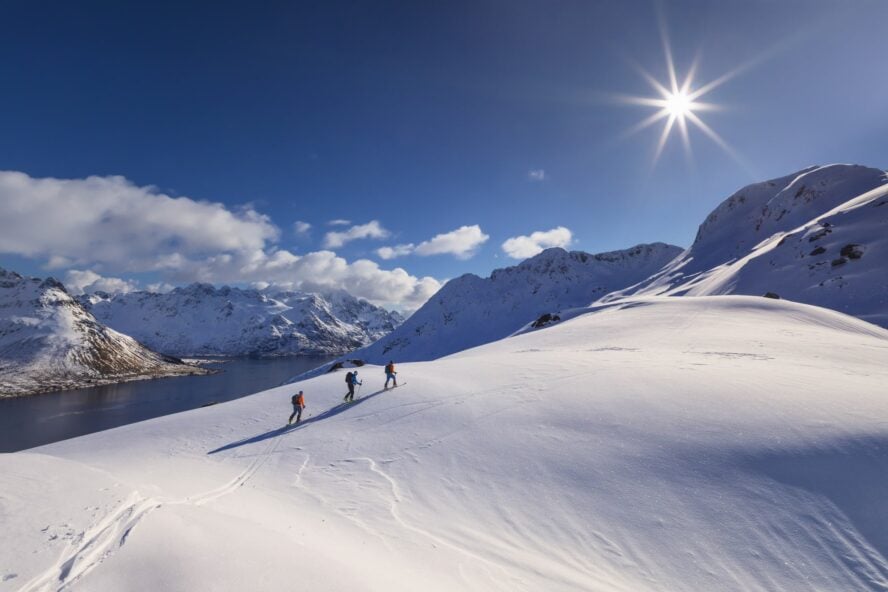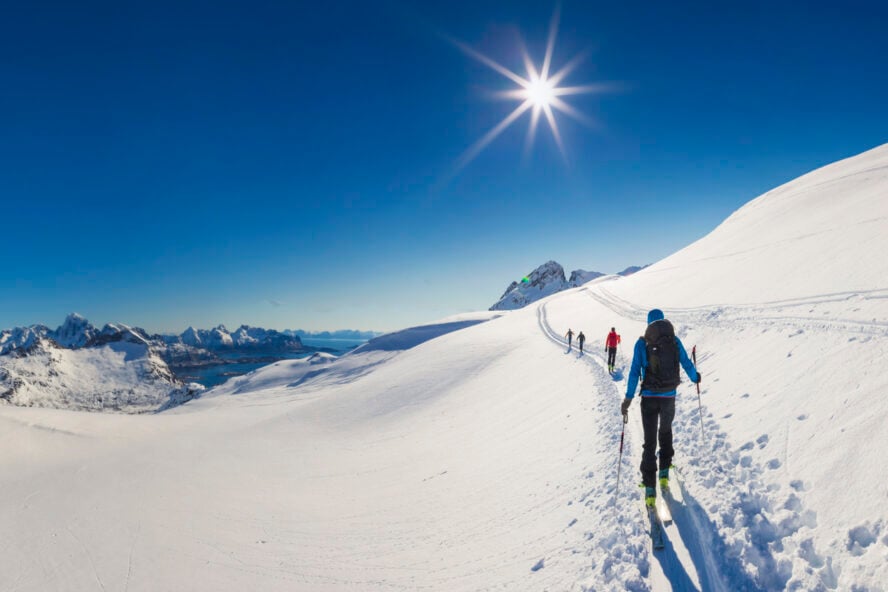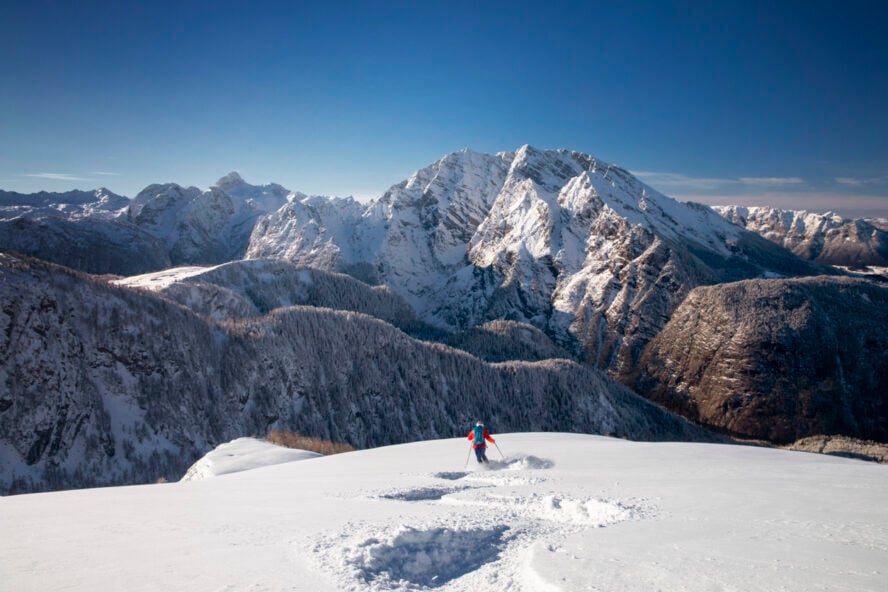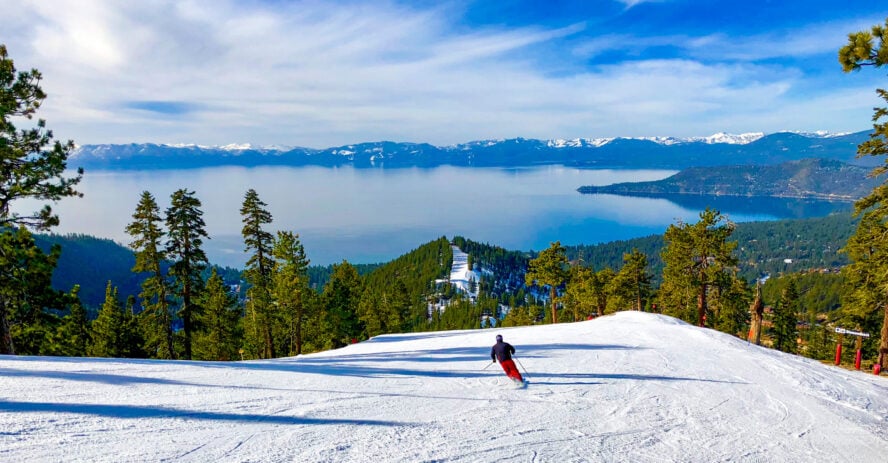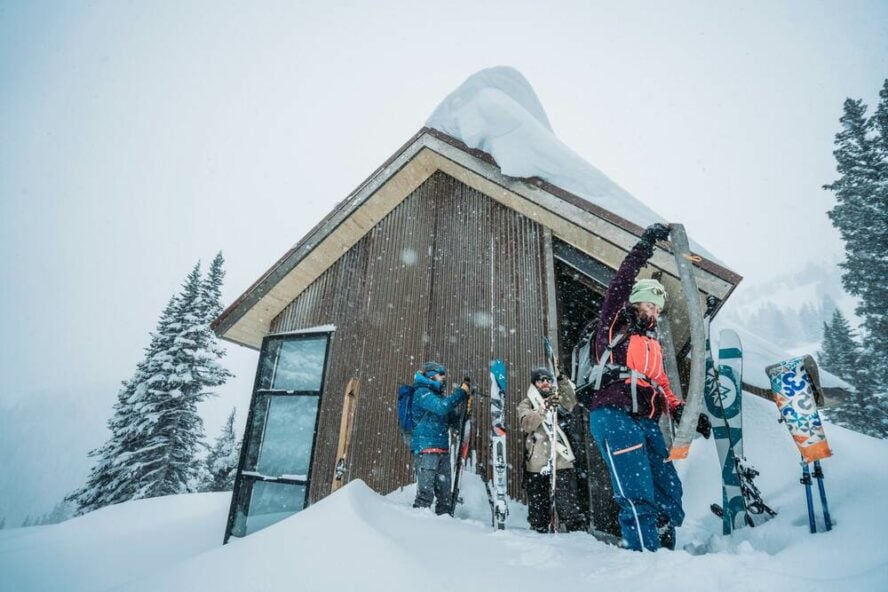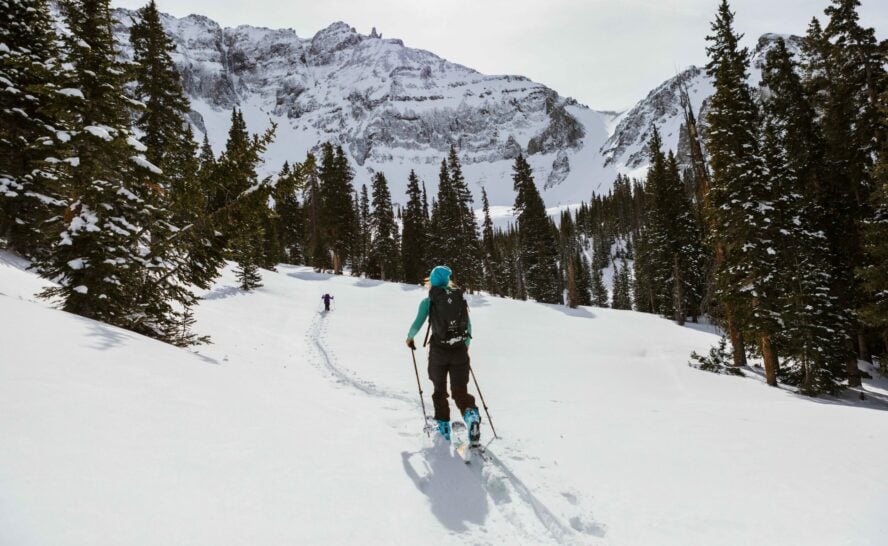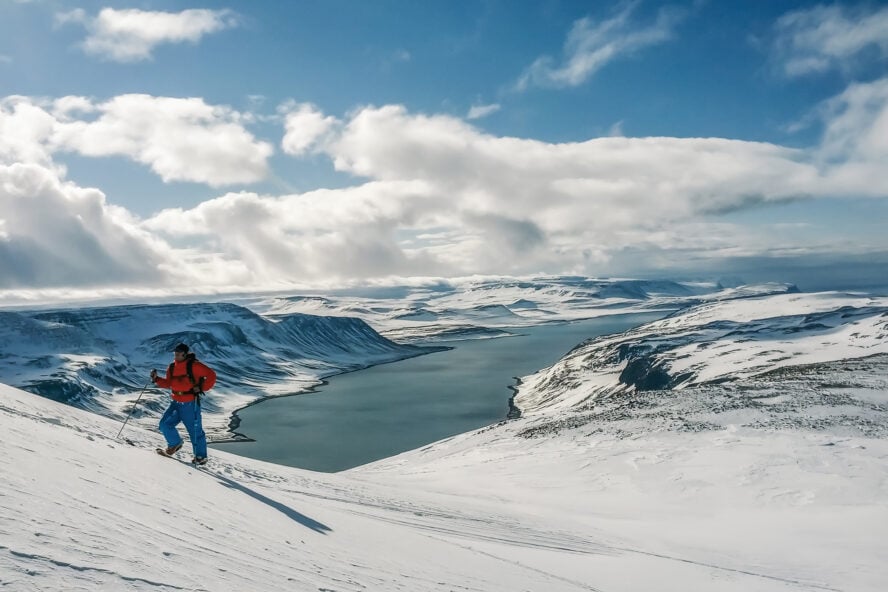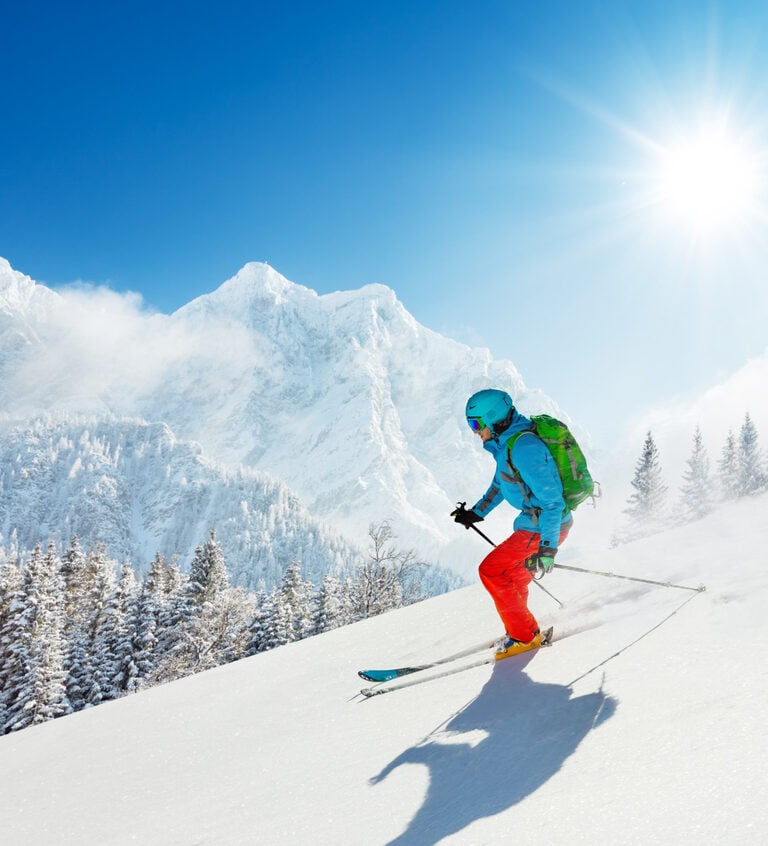Tired of endless lift lines or overpaying for soggy slope-side sandwiches? Backcountry skiing offers an escape, a chance to trade crowded runs and everyday experiences for untouched powder and unforgettable adventures. But what is backcountry skiing, anyway?
We’re backcountry skiers who have been chasing fresh lines for years, and once you try it, you’ll never go back to the resorts.
This guide covers everything: what backcountry skiing is, why it’s taking off, the gear you need, safety essentials, and top spots for newbies and shredders.
Ready to ditch the groomers and carve your own lines?
What is backcountry skiing, anyway?
What backcountry skiing essentially is is skiing in the wild, outside resort boundaries, where snow stays untouched and the vibe feels pure.
You ski raw, natural terrain with no groomed trails or chairlifts. Most skiers use touring gear, light skis, sticky skins, and special bindings to hike up and earn their descents. You chase powder in places nobody’s touched.
No ski patrol, no crowds. Just you, your crew, and the mountain.
Backcountry skiing is booming in popularity because resorts feel chaotic. Too many people, too much noise. Backcountry offers quiet and freedom.
But it’s not like hopping off a lift. You need skills, a solid ski setup, and sharp safety know-how, especially for avalanches. This is why we always recommend doing your first foray into the backcountry with a guide.
Backcountry skiing, ski touring, freeriding: understanding the terminology
The jargon can confuse you when you’re new. Backcountry, ski touring, off-piste, freeriding all relate but differ. Here’s the breakdown to keep it clear.
Backcountry Skiing
Backcountry skiing focuses on location: uncontrolled, natural terrain outside resorts. No groomers or patrols exist. You might skin up, hike, or catch a heli to get there. You generally ski on untouched snow, powder, crust, or spring corn. Avalanches pose a real threat, so safety gear matters.
The term “backcountry” covers sidecountry near resorts to remote peaks nobody skis. In essence, backcountry skiing delivers the freedom of fresh tracks.
Ski Touring
Ski touring describes the method to reach backcountry lines. You use lightweight skis with skins, sticky strips that grip snow for climbing. At the top, you peel them off and ski down. You can tour near a resort or deep in the wild. It mixes uphill grind with downhill excitement.
Ski touring suits all levels, as you’ll find everything from chill slopes to big missions, with the right setup.
Off-piste Skiing
Off-piste means skiing ungroomed snow, usually within or near a resort’s area. You ride a lift up but skip marked trails for powder stashes or bumpy terrain. It’s less remote than backcountry, with some safety net like nearby patrols. Avalanches still pose risks, so stay sharp.
It introduces you to wild snow without full wilderness. Resorts like Chamonix offer world-class off-piste zones to ease you in.
Freeriding
Freeriding focuses on the vibe of the descent: creative, stylish runs with jumps, cliffs, or slashing powder. It can be done in backcountry or off-piste zones. The priority is fun over fixed lines. Picture dropping a big air or carving a deep pow turn. Freeriders might tour to their runs or use lifts, often with heavier resort-style gear. It suits skiers who love to play and push limits with flair. Freeride World Tour energy.
These terms blend. Backcountry often involves touring. Off-piste serves as a gateway. Freeriding describes the playfulness. We’re sure you’ll find your vibe.
Why more and more people are getting into backcountry skiing
Backcountry skiing is gaining traction fast, and it’s no shock why.
Resorts often feel like a zoo: long lift lines, packed slopes, and too many people fighting for the same run. It kills the mood. Backcountry takes you to quiet corners where your tracks stand alone. Resort food costs a fortune; a €25 burger and soda. In the backcountry, you pack snacks or hit local spots for better food at half the price.
The adventures blow your mind. Picture carving powder under Norway’s midnight sun, the sky glowing like a dream. Or stepping out of a British Columbia lodge for runs right from the door. Resorts can’t match that magic.
Also, backcountry skiing tests you. If you tour, the uphill climb builds stamina, and nailing a tricky descent feels like a personal win. It’s you against the mountain, and that’s a rush.
Nature itself pulls many skiers in. Resorts often feel like theme parks, loud and commercial. Backcountry immerses you in raw wilderness: silent pine forests, wildlife like deer or hawks, sunrises that hit deep. We’ve seen skiers stop mid-run, just staring at a view that grabs their soul.
Social media drives the hype; Instagram is full of cool-looking backcountry shots that inspire more to try it. Gear sales rise up to 50% yearly, and avalanche courses sell out fast.
What is needed to start backcountry skiing?
Diving into backcountry skiing requires specific gear. You can’t grab your resort setup and wing it. You need equipment for wild terrain and a mindset for adventure and safety. Here’s the full rundown.
The skis
Backcountry skis, often touring skis, prioritize light weight over resort ones for easier climbing. Carbon or lightweight wood cores cut ounces, which is a big difference for long skinning sessions.
Widths of 80-100mm underfoot balance grip on climbs with float in powder. Wider skis (100mm+) excel in deep snow; narrower (80-90mm) suit hardpack or traverses. Camber ensures precise turns; rocker boosts flotation in pow.
Skins, nylon or mohair strips, stick to the ski base for uphill grip. They glide forward but grip backward, and peel off for descents.
Bindings matter: tech bindings use toe pins for walking, with free heels. Frame bindings are heavier, but they work with resort boots. A full setup (skis, bindings, skins) will set you back €500-1200 for starters.
How to get the right skis
The number one rule is never buy blind. Rent first at bigger shops or local outfitters to test gear.
Try widths: 100mm+ for powder, 80-90mm for mixed snow or long tours. Match length to height, chin to forehead, and weight for control.
Ensure bindings match boots; tech bindings need pin-compatible ones. Skins must fit ski length and width; trim them for full coverage.
Budget €500-1200 for a solid kit. Talk to shop staff or your guide for recs. They match gear to your trip and skills. Many skiers learned the hard way: wrong skis make climbs brutal and descents shaky.
The shoes
Backcountry boots, usually touring boots, weigh less than resort ones and feature a walk mode switch to loosen the cuff for hiking.
They stay stiff for descents, with flex ratings of 90-120 for most skiers. Liners mold to feet to prevent blisters on long days. Soles, rockered for easier walking, have grippy lugs for boot packs.
Tech boots use pin holes for lightweight bindings; hybrid boots work with frame bindings or resort setups. Fit matters a lot. Go for snug but comfy, no heel lift. Try them with ski socks, test walk mode, and walk around. Budget €400-800. Custom insoles help for odd feet.
Clothing and gear
Backcountry skiing is all about layering. Here’s a cheat sheet.
Base layer: merino wool wicks sweat and keeps you warm, even wet.
Mid-layer: fleece or light puffy insulates on chilly descents.
Shell: waterproof, breathable Gore-Tex blocks wind, snow, or slush.
Pants: softshell for flexibility or hardshell for storms, depending on where you’re skiing. Vents for heat.
Gloves: thin for climbing, warm for shredding.
Add a hat, neck buff, sunglasses, and goggles for snow glare. A 20-30L backpack should be enough to carry your gear; ski-specific ones have straps for boards. Adjustable trekking poles with powder baskets can aid with balance on climbs or traverses.
Other backcountry skiing necessities
You need more than skis and clothes.
Avalanche gear: beacon, shovel, probe, carry them every time.
Navigation: map, compass, or GPS app like Gaia or CalTopo for routes.
Hydration: 2L bladder or bottles; insulate to prevent freezing.
Nutrition: bars, gels, or sandwiches for long days.
First aid: blister patches, ibuprofen, bandages. Headlamp for early starts or late finishes.
Repair kit: multi-tool, duct tape, spare binding screws.
Ski straps for bundling gear. Crampons for icy slopes or boot packs. Sunscreen and lip balm for UV protection; snow reflects hard. Phone with offline maps and a backup battery for emergencies. Pack light but never skip on safety.
Avalanche Safety: A Must for Backcountry Skiing
Avalanches scare everyone out there. They kill about 150 skiers worldwide each year, the top danger in the backcountry. Many of our guides have seen slides up close, and they all said the same thing: they move fast. Gear and knowledge keep you alive.
You need a beacon (transceiver) to send and receive signals for finding buried skiers. Practice searches; speed saves lives in avalanches. A lightweight metal shovel digs victims out fast. A 2.5m probe pinpoints their spot under the snow. An airbag pack (€500-1000) inflates to keep you on top of a slide.
The trio costs €500-800. Rent if you’re testing the waters. Carry this gear every trip, no excuses.
Knowledge matters as much. Take an Avalanche Safety Course like AIARE Level 1. It runs 2-3 days, €300-500, and teaches snowpack science, terrain analysis, and rescue skills.
Check daily forecasts on Avalanche.org or local reports. Practice beacon drills with buddies; I do it every season to stay sharp. Don’t go without a course if you’re solo, it’s a lifesaver.
Most guided backcountry ski trips include some safety training, with IFMGA pros who know snowpack and terrain like their own backyard. They keep you safe while you learn.
Group dynamics play a role too. Peer pressure can lead to bad calls. Stay conservative, especially as a newbie. I’ve turned back from runs that felt wrong, and it’s always smart. Weather impacts risk; storms or warm spells spike avy danger. Check conditions before heading out.
What is the best backcountry skiing destination for beginners?
New to backcountry? Start with forgiving terrain and nearby support. You want spots to build skills without diving in too deep. Here’s our top three backcountry skiing destinations for beginners.
The European Alps
The Alps shine for beginners. Resorts like Chamonix, France, or Zermatt, Switzerland, make the backcountry extremely accessible.
Lifts cut some uphill work, which lets you focus on shredding ungroomed snow. Patrolled zones nearby offer a safety net if you’re not ready for full wilderness. Gentle runs like Les Houches’ meadows or Vallée Blanche let you practice without steep risks. Snow sticks around from December to April, with spring offering stable conditions and long days.
Avalanche control ranks among the best, and rescue teams stay close. The après-ski steals the show: fondue, mulled wine, cozy chalets. I’ve seen newbies grin ear-to-ear after their first powder turn here. A backcountry ski trip in the Alps will teach you skills while you soak in Alpine vibes.
Japan
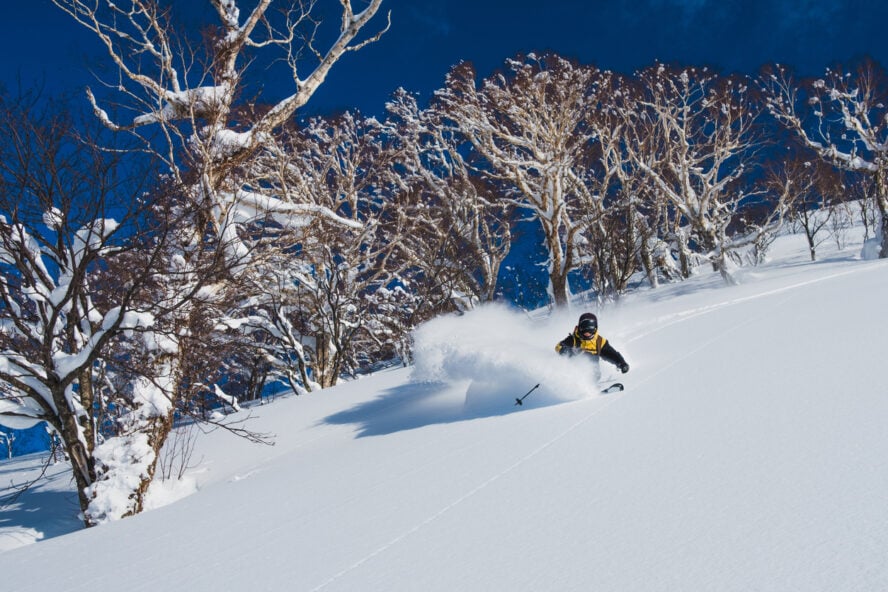
Japan’s JaPow feels like skiing on a cloud. Perfect for beginners.
The snow’s the lightest, fluffiest anywhere, thanks to cold Siberian air hitting warm ocean currents. Low-angle runs in Hokkaido’s Niseko, Furano, or Rusutsu forgive falls; you crash soft in deep pow. It’s ideal for practicing turns or getting comfy in ungroomed snow.
Birch forests with snow-covered “ghost trees” look like a fairy tale. The culture is a big part of the experience: onsens that melt sore muscles, and ramen or sushi are a cheap refuel. Way better than resort grub.
Snow dumps from January to March for endless pow days. You’ll learn to ski safely while you float through unreal snow. It’s a whole experience.
British Columbia
British Columbia’s lodge-based backcountry trips suit beginners perfectly.
The terrain’s huge in areas like Selkirks, Revelstoke, or Monashees, with options for every level. Gentle glades and open bowls let you ease into ungroomed snow without stress. Heli-ski drops skip tough climbs, getting you to sweet descents fast.
Lodges in BC mean luxury: private chefs cook gourmet meals, saunas and hot tubs are there for post-ski relaxation, and guides handle everything. Snow’s deep from December to April, with tree skiing that’s fun and safer in low visibility.
Beginners can go from nervous to stoked in a day, nailing powder turns with a guide’s help. It’s the cushiest way to dive into backcountry with killer powder.
What is the best backcountry skiing destination for more advanced skiers?
Got backcountry experience? You’re ready for wilder challenges. These spots cater to advanced skiers chasing remote, gnarly lines.
Norway
Norway is a beast for serious backcountry skiing.
Sail-and-ski trips in Svalbard and the Lyngen Alps deliver next-level adventure. You cruise fjords by boat, skin up, and hit untouched runs. Arctic powder stays pristine, blending with spring corn from March to May. Peaks reach 1000-1500 meters (3281-4921 feet), with summit-to-sea descents ending at the fjord’s edge.
All-day skiing under the midnight sun rocks; 24-hour daylight lets you shred as long as you can handle. Fjord views and northern lights are magic. You’ll hit everything from steep chutes to flowy faces.
There’s always an avalanche risk, so local knowledge is key. We’ve skied Lyngen under auroras, and it’s pure fire.
Georgia
Georgia’s Caucasus Mountains are a true hidden gem for advanced skiers, with the highest runs in Europe.
They’re raw, less polished than the Alps, perfect if you’re looking for pure adventure. Peaks like Mount Kazbek soar past 5000 meters (16404 feet), with snow from February to May. You can ski weeks without seeing another soul. Paradise for solitude seekers.
Steep couloirs, big faces, and deep valleys will truly test your skills. The snow is stable but varies, so avalanche know-how matters. The culture’s a treat: Georgian wine, hearty khachapuri bread, and warm hospitality are just the thing to refuel you.
Skiing in Georgia is ideal for skiers who love untamed terrain and can handle logistical chaos.
Greenland
For hardcore skiers, Greenland is by far the most immersive and exciting experience.
It’s pure remoteness: summit-to-sea runs with glaciers and icebergs everywhere. Peaks around Kangerlussuaq offer 800-1200 meter (2625-3937 feet) descents, with endless powder. You might even spot whales, seals, or polar bears while sailing to your next run.
March to April is the sweet spot, with stable snow and long days.
Logistics can be quite tough; getting there and staying safe takes planning. Avalanches and crevasses raise risks. Guided trips are a must here
The reward? Lines nobody else skis, in a landscape that’s pure spectacle. Greenland is for skiers chasing stories they’ll tell forever.
Why your first backcountry skiing trip should be with a guide
A skier’s first backcountry trip is always a big leap.
Go with a guide to keep it smooth. They handle the logistics: routes, transport, lodging. No stressing over maps or bookings. They’ll also share gear tips, which could save you from buying wrong.
They’ll watch your technique, fixing sloppy turns or bad habits to make you sharper. Safety is critical: guides know avalanches, they’ll read terrain help you avoid sketchy zones. They pick runs matching your skills, so you’re not stuck on a gnarly slope or bored on easy stuff.
You’ll earn group dynamics, pacing, and communication. Our first guided trip turned us into powder chasers. You’ll come out buzzing, ready for more.
What is backcountry skiing? It’s just what you need
So what is backcountry skiing? It’s your escape from resort chaos.
You get untouched powder, wild terrain, and the thrill of carving your own lines. Grab the right skis, boots, and avy gear. Learn safety, it’s a must. Start in beginner spots to build confidence. Ready for more? Push your limits in crazier ski spots.
A guide will make your first trip safe, fun, and a game-changer. Like us, you’ll never want to see a lift line again.

